
|
It brightened up to 9.0 mag in 2012 autumn (Nov. 4, Juan Jose Gonzalez). It is not observable now. In the Southern Hemisphere, it will appear in the morning sky at 9 mag in 2013 February, then it keeps observable in good condition while fading slowly. In the Northern Hemisphere, it is hardly observable after 2013.
Date(TT) R.A. (2000) Decl. Delta r Elong. m1 Best Time(A, h)
Nov. 10 16 21.05 -10 26.1 2.864 1.967 20 9.5 18:24 ( 76, 2)
Nov. 17 16 34.48 -13 2.9 2.862 1.935 16 9.4 18:21 ( 75, -2)
|

|
It is expected to be a great comet of -1 mag in 2013 spring. It brightened up to 10.1 mag in 2012 autumn (Oct. 14, Marco Goiato). It brightened faster than originally expected. It is not observable now. In the Southern Hemisphere, it will appear in the morning low sky at 8 mag in late December. In the Northern Hemisphere, it keeps unobservable for a long time until 2013 March, when the comet will appear as a 0-mag great comet.
Date(TT) R.A. (2000) Decl. Delta r Elong. m1 Best Time(A, h)
Nov. 10 15 47.29 -30 57.9 3.342 2.414 17 10.4 18:24 ( 63,-16)
Nov. 17 15 55.92 -31 51.1 3.257 2.311 14 10.2 18:21 ( 64,-20)
|
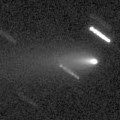
|
Now it is bright at 10.2 mag (Nov. 6, Juan Jose Gonzalez). It is expected to approach to the earth and to be observable at 8 mag in good condition in winter. The condition is good in the Northern Hemisphere. It turns to be in the morning sky after November, and will be getting higher rapidly. In the Southern Hemisphere, it is not observable now. But it will become observable in good condition after 2013 January.
Date(TT) R.A. (2000) Decl. Delta r Elong. m1 Best Time(A, h)
Nov. 10 14 24.00 41 25.4 1.326 1.181 59 11.0 5:03 (234, 22)
Nov. 17 14 19.51 42 17.2 1.189 1.157 63 10.7 5:08 (236, 28)
|

|
It brightened very rapidly. Now it is very bright visually as 10.3 mag (Nov. 6, Juan Jose Gonzalez). It keeps high for a long time in the Northern Hemisphere. But the comet will be fading after this. It locates very low in the Southern Hemisphere. The nuclear split was observed in late October.
Date(TT) R.A. (2000) Decl. Delta r Elong. m1 Best Time(A, h)
Nov. 10 23 41.38 38 14.0 0.625 1.481 131 11.0 20:22 (180, 87)
Nov. 17 23 46.18 39 30.7 0.680 1.506 127 11.6 19:59 (180, 85)
|

|
Now it is bright as 11.4 mag (Oct. 15, Chris Wyatt). It is expected to be observable at 11-13 mag for a long time from 2012 summer to 2013 summer. It is not observable until 2013 January in the Northern Hemisphere. In the Southern Hemisphere, it will be extremely low from October to December.
Date(TT) R.A. (2000) Decl. Delta r Elong. m1 Best Time(A, h)
Nov. 10 15 8.62 -43 40.4 2.933 2.095 26 12.0 18:24 ( 55,-29)
Nov. 17 15 18.05 -42 8.9 2.978 2.107 23 12.1 5:08 (304,-27)
|

|
It kept as bright as 6-7 mag for a long time from 2011 summer to 2012 spring. Now it is fading. But it is very bright as 12.8 mag still now (Oct. 20, Katsumi Yoshimoto).
Date(TT) R.A. (2000) Decl. Delta r Elong. m1 Best Time(A, h)
Nov. 10 10 7.03 -3 42.7 4.347 4.170 73 12.9 5:03 (321, 44)
Nov. 17 10 5.54 -4 42.7 4.293 4.236 80 12.9 5:08 (333, 47)
|

|
It brightened up to 11-12 mag in 2012. Now it is not observable. But it will be observable at 12-13 mag in good condition again in 2013.
Date(TT) R.A. (2000) Decl. Delta r Elong. m1 Best Time(A, h)
Nov. 10 15 24.58 -15 23.4 6.351 5.367 5 13.4 18:24 ( 80,-13)
Nov. 17 15 26.30 -15 39.1 6.369 5.383 3 13.4 5:08 (279,-16)
|
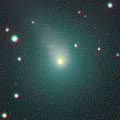
|
It brightened much faster than expected. Now it is so bright as 11.5 mag (Sept. 15, Seiichi Yoshida). In the Northern Hemisphere, it keeps observable at 11-13 mag in good condition until early 2013. In the Southern Hemisphere, it is not observable until late 2012.
Date(TT) R.A. (2000) Decl. Delta r Elong. m1 Best Time(A, h)
Nov. 10 9 59.76 27 28.8 2.368 2.495 85 13.5 5:03 (283, 67)
Nov. 17 9 53.82 26 9.1 2.282 2.537 93 13.6 5:08 (300, 74)
|
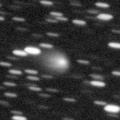
|
Now it is 13.0 mag (Nov. 6, Juan Jose Gonzalez). It keeps bright at 13-14 mag for a long time until 2014. It keeps observable for a long time in the Northern Hemisphere. It is not observable in the Southern Hemisphere.
Date(TT) R.A. (2000) Decl. Delta r Elong. m1 Best Time(A, h)
Nov. 10 20 39.10 40 42.7 5.852 6.053 96 13.6 18:24 (119, 76)
Nov. 17 20 38.54 39 14.0 5.919 6.042 92 13.6 18:21 (110, 72)
|

|
Now it is bright as 13.3 mag (Oct. 19, Jakub Cerny). It keeps bright as 13-14 mag for a long time after this until 2013. It is not observable in the Northern Hemisphere, but it is observable in good condition in the Southern Hemisphere.
Date(TT) R.A. (2000) Decl. Delta r Elong. m1 Best Time(A, h)
Nov. 10 3 59.55 -57 20.7 5.593 5.919 104 13.9 0:43 ( 0, -2)
Nov. 17 3 50.04 -56 52.9 5.622 5.939 104 13.9 0:06 ( 0, -2)
|

|
Now it is bright and visible visually at 11.8 mag (Nov. 6, Juan Jose Gonzalez). It keeps observable in good condition at 13-14 mag for a long time until winter. It locates somewhat low in the Southern Hemisphere.
Date(TT) R.A. (2000) Decl. Delta r Elong. m1 Best Time(A, h)
Nov. 10 23 43.37 29 1.2 2.408 3.170 133 13.9 20:24 ( 0, 84)
Nov. 17 23 46.51 27 26.1 2.455 3.165 128 14.0 19:59 ( 0, 82)
|

|
Appearing in the morning sky. Now it is 15.3 mag, much brighter than origianlly predicted (Oct. 14, Hidetaka Sato). It is expected to brighten up to 5-6 mag in 2013 spring. In the Southern Hemisphere, it keeps observable while brightening gradually after this in good condition. In the Northern Hemisphere, it is only observable until early January when it becomes 10 mag. After 2013 May, it keeps observable in good condition while fading gradually.
Date(TT) R.A. (2000) Decl. Delta r Elong. m1 Best Time(A, h)
Nov. 10 11 23.08 -7 18.4 2.809 2.368 54 14.4 5:03 (305, 30)
Nov. 17 11 29.25 -9 44.5 2.625 2.276 58 14.0 5:08 (313, 32)
|

|
First return of a new periodic comet which brightened up to 14 mag in 2005. It brightened very rapidly and became much brighter than originally expected. Now it is very bright as 12.2 mag (Oct. 9, Uwe Pilz). It keeps high for a long time in the Northern Hemisphere. But the comet will be fading after this. It locates very low in the Southern Hemisphere.
Date(TT) R.A. (2000) Decl. Delta r Elong. m1 Best Time(A, h)
Nov. 10 1 31.91 42 40.1 0.695 1.623 148 14.0 22:12 (180, 82)
Nov. 17 1 30.28 42 39.1 0.740 1.652 145 14.3 21:43 (180, 82)
|

|
It brightened rapidly, and reached up to 12 mag in 2012. It is not observable now. But it will be observable at 12-14 mag in good condition again in 2013. However, it locates somewhat low in the Northern Hemisphere in 2013.
Date(TT) R.A. (2000) Decl. Delta r Elong. m1 Best Time(A, h)
Nov. 10 15 35.58 -14 46.0 3.887 2.912 8 14.1 18:24 ( 79,-10)
Nov. 17 15 47.07 -15 44.0 3.890 2.906 5 14.0 18:21 ( 80,-13)
|

|
Not observable now. It will appear in the morning sky in late November.
Date(TT) R.A. (2000) Decl. Delta r Elong. m1 Best Time(A, h)
Nov. 10 13 29.14 -17 41.1 7.150 6.243 22 14.2 5:03 (292, 0)
Nov. 17 13 33.99 -18 13.2 7.102 6.242 27 14.2 5:08 (296, 5)
|

|
Big asteroid discovered in 1906. It suddenly showed the cometary activity on Dec. 11, 2010, probably due to an impact of a small object. Now it is 11.9 mag (May 29, Marco Goiato). It has already turned to be stellar.
Date(TT) R.A. (2000) Decl. Delta r Elong. m1 Best Time(A, h)
Nov. 10 18 26.88 -31 28.8 3.108 2.561 48 14.3 18:24 ( 41, 9)
Nov. 17 18 40.74 -31 24.6 3.180 2.570 44 14.3 18:21 ( 42, 8)
|

|
Now it is visible visually at 14.7 mag (Nov. 6, Juan Jose Gonzalez). It is expected to brighten up to 10 mag from winter to spring in 2013. In the Northern Hemisphere, it keeps observable in good condition until 2013 April. It is not observable now in the Southern Hemisphere. It will become observable after 2013 April, but it keeps locating low.
Date(TT) R.A. (2000) Decl. Delta r Elong. m1 Best Time(A, h)
Nov. 10 19 27.16 82 44.0 2.377 2.789 104 14.8 18:24 (175, 41)
Nov. 17 20 6.75 81 34.5 2.279 2.720 105 14.6 18:21 (174, 42)
|

|
Now it is 15.7 mag (Oct. 7, V. Gerke, A. Novichonok, S. Plaksa). It will brighten up to 15 mag from autum to winter. In the Northern Hemisphere, it keeps observable for a long time until the comet fades out. It is not observable in the Southern Hemisphere, except for 2013 spring, but the comet locates extremely low only.
Date(TT) R.A. (2000) Decl. Delta r Elong. m1 Best Time(A, h)
Nov. 10 13 52.37 71 1.1 2.117 2.321 88 15.3 5:03 (203, 35)
Nov. 17 13 55.96 73 0.6 2.025 2.304 93 15.2 5:08 (201, 37)
|

|
Now it is 15.7 mag (Sept. 25, Hiroshi Abe)�$B!#�(BIt keeps 15-16 mag from autumn to winter. It keeps observable in good condition for a long time until the comet fades out in the Northern Hemisphere. It is not observable until 2013 summer in the Southern Hemisphere. By the way, Juan Jose Gonzalez reported it extremely bright as 10.4 mag visually on Nov. 6.
Date(TT) R.A. (2000) Decl. Delta r Elong. m1 Best Time(A, h)
Nov. 10 10 0.48 83 37.3 3.143 3.538 105 15.5 5:03 (184, 41)
Nov. 17 9 0.61 86 54.5 3.086 3.539 109 15.5 5:08 (180, 38)
|

|
It is expected to keep 13 mag and observable in good condition in the Northern Hemisphere for a long time from 2013 to 2014. Now it is 15.8 mag (Oct. 19, Hiroshi Abe). It will be observable also in the Southern Hemisphere from early December to early March, although it locates low.
Date(TT) R.A. (2000) Decl. Delta r Elong. m1 Best Time(A, h)
Nov. 10 11 25.97 18 9.4 5.384 5.024 63 15.7 5:03 (280, 46)
Nov. 17 11 28.40 18 50.5 5.227 4.981 70 15.6 5:08 (285, 52)
|

|
Now it is 14.8 mag (Oct. 7, Jakub Cerny). In the Southern Hemisphere, it will be observable at 15-16 mag in good condition for a long time until 2013 summer. It is not observable at all in the Northern Hemisphere.
Date(TT) R.A. (2000) Decl. Delta r Elong. m1 Best Time(A, h)
Nov. 10 19 1.96 -80 38.5 4.214 3.958 68 15.6 18:24 ( 7,-28)
Nov. 17 19 36.65 -80 26.6 4.255 3.969 66 15.6 18:21 ( 6,-27)
|

|
First return of a new periodic comet discovered in 1994. Now it is 17.0 mag (Yasukazu Ikari). It was expected to brighten rapidly, to reach up to 13.5 mag, and to be observable in good condition from autumn to winter. But actually, it is much fainter than this ephemeris. It will be 15-16 mag at best.
Date(TT) R.A. (2000) Decl. Delta r Elong. m1 Best Time(A, h)
Nov. 10 21 1.09 7 0.8 0.844 1.323 91 15.8 18:24 ( 21, 60)
Nov. 17 21 26.04 4 12.8 0.840 1.302 90 15.8 18:21 ( 19, 58)
|

|
It kept as bright as 11-12 mag for a long time from 2011 autumn to 2012 spring. Now it is 16.4 mag (Sept. 25, Hiroshi Abe). It keeps observable in good condition until next spring while the comet will be fading gradually.
Date(TT) R.A. (2000) Decl. Delta r Elong. m1 Best Time(A, h)
Nov. 10 10 18.90 4 19.5 3.153 3.015 72 15.8 5:03 (311, 49)
Nov. 17 10 24.38 3 38.1 3.088 3.047 78 15.9 5:08 (321, 52)
|
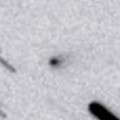
|
Now it is 17.5 mag (Oct. 17, A. Knoefel). It approaches to the Sun down to 0.3 A.U. in 2013 February. The ephemeris says it will brighten up to 7 mag. However, because the comet is small, it may be disintegrated. It keeps observable in good condition until February while brightening gradually.
Date(TT) R.A. (2000) Decl. Delta r Elong. m1 Best Time(A, h)
Nov. 10 3 35.09 13 24.6 1.199 2.183 171 16.3 0:19 ( 0, 69)
Nov. 17 3 16.41 9 42.2 1.094 2.075 170 15.9 23:27 ( 0, 64)
|
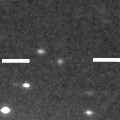
|
It is expected to be a great comet in 2013 autumn when the comet approaches to the sun down to only 0.01 A.U. It keeps visible with naked eyes from November to January, and can be extremely bright as Venus or more at the highlight. Now it is 17.2 mag (Oct. 12, A. Knoefel). The condition is excellent in the Northern Hemisphere. It keeps observable almost all through the period of brightening, at the highlight, and of fading. The condition is not good in the Southern Hemisphere. It is not observable at all the latter part of the highlight, and it keeps low all through the period. The orbit is similar to that of Comet Kirch in 1680.
Date(TT) R.A. (2000) Decl. Delta r Elong. m1 Best Time(A, h)
Nov. 10 8 20.87 28 21.6 5.436 5.799 106 16.8 5:03 (358, 83)
Nov. 17 8 19.55 28 35.6 5.254 5.729 114 16.7 4:35 ( 0, 84)
|

|
Although it was extremely faint as 20.5 mag in September, it must be brightening very rapidly. It will reach up to 13 mag from winter to spring. In the Northern Hemisphere, it keeps observable in excellent condition. In the Southern Hemisphere, it keeps locating extremely low for a while.
Date(TT) R.A. (2000) Decl. Delta r Elong. m1 Best Time(A, h)
Nov. 10 9 31.87 37 9.5 2.150 2.436 94 17.3 5:03 (256, 75)
Nov. 17 9 42.78 36 56.9 2.038 2.398 98 16.9 5:08 (256, 80)
|

|
It brightened rapidly, and reached up to 10 mag from July to August. Now it is fading. But it is bright as 13.6 mag still now (Oct. 16, Gerke, A. Novichonok, S. Plaksa). It keeps observable in the morning sky after this.
Date(TT) R.A. (2000) Decl. Delta r Elong. m1 Best Time(A, h)
Nov. 10 10 29.58 -4 54.0 1.605 1.530 67 17.0 5:03 (316, 40)
Nov. 17 10 39.28 -6 31.2 1.605 1.597 71 17.6 5:08 (324, 42)
|

|
New comet. It will brighten up to 12 mag from summer to autumn in 2013. In the Northern Hemisphere, it is observable only until 2013 spring when the comet brightens up to 15 mag. In the Southern Hemisphere, it keeps unobservable until 2013 August. Then it keeps observable while fading gradually.
Date(TT) R.A. (2000) Decl. Delta r Elong. m1 Best Time(A, h)
Nov. 10 21 22.91 70 25.4 3.375 3.798 107 17.4 18:24 (177, 54)
Nov. 17 21 28.96 68 53.9 3.310 3.729 107 17.3 18:21 (174, 56)
|
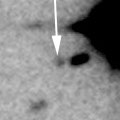
|
Now it is 17.2 mag (Sept. 29, K. Hills). In the Southern Hemisphere, it keeps observable at 17 mag in good condition for a long time from 2012 to 2013. It is not observable at all in the Northern Hemisphere.
Date(TT) R.A. (2000) Decl. Delta r Elong. m1 Best Time(A, h)
Nov. 10 6 37.60 -70 34.7 4.875 4.885 84 17.3 3:20 ( 0,-16)
Nov. 17 6 20.29 -72 24.9 4.876 4.878 84 17.3 2:36 ( 0,-17)
|
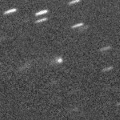
|
Now it is 17.4 mag (Oct. 4, Catalina Sky Survey). It keeps 17 mag for a long time from 2009 to 2013.
Date(TT) R.A. (2000) Decl. Delta r Elong. m1 Best Time(A, h)
Nov. 10 22 16.49 7 36.4 8.221 8.612 110 17.4 18:57 ( 0, 63)
Nov. 17 22 14.52 7 11.0 8.354 8.627 102 17.5 18:27 ( 0, 62)
|
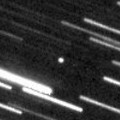
|
Now it is 17.4 mag (Sept. 29, Jean-Francois Soulier). In the Northern Hemisphere, it will be observable at 17.5 mag in excellent condition in October and November. It locates low in the Southern Hemisphere.
Date(TT) R.A. (2000) Decl. Delta r Elong. m1 Best Time(A, h)
Nov. 10 1 46.95 39 18.8 1.364 2.289 152 17.5 22:25 (180, 86)
Nov. 17 1 31.67 36 56.1 1.409 2.311 148 17.6 21:43 (180, 88)
|

|
New asteroid with a very small perihelion distance of 0.38 A.U. Now it is 16.5 mag (Oct. 24, Yasukazu Ikari). It will be observable at 17 mag in excellent condition from mid October to mid November in the Northern Hemisphere. It locates extremely low in the Southern Hemisphere.
Date(TT) R.A. (2000) Decl. Delta r Elong. m1 Best Time(A, h)
Nov. 10 20 11.23 32 47.7 0.697 1.202 89 17.5 18:24 ( 90, 71)
Nov. 17 20 43.47 34 26.1 0.845 1.317 91 18.0 18:21 ( 94, 73)
|

|
It brightened up to 12 mag in 2010. Now the comet is around the aphelion. But it will be observable at 17.5 mag in good condition from autumn to winter. Now it is 19.4 mag (Oct. 9, Mt. Lemmon Survey), fainter than this ephemeris.
Date(TT) R.A. (2000) Decl. Delta r Elong. m1 Best Time(A, h)
Nov. 10 4 28.51 20 55.7 3.681 4.619 159 17.6 1:12 ( 0, 76)
Nov. 17 4 23.72 20 52.6 3.658 4.627 167 17.6 0:40 ( 0, 76)
|
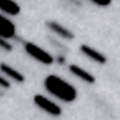
|
Now it is 17.4 mag (Sept. 29, A. Diepvens). It keeps 17-18 mag for a long time until the end of 2013. The condition is good in the Northern Hemisphere. It is hardly observable in 2012 in the Northern Hemisphere. But it will be observable in good condition in 2013.
Date(TT) R.A. (2000) Decl. Delta r Elong. m1 Best Time(A, h)
Nov. 10 23 42.31 49 20.3 4.009 4.692 128 17.7 20:22 (180, 76)
Nov. 17 23 36.00 46 57.4 4.032 4.671 125 17.7 19:48 (180, 78)
|

|
Jakub Cerny reported the comet brightened up to 14.5 mag in late July. It is bright as 15.7 mag still now (Oct. 19, Jakub Cerny). It will be observable in good condition in the Southern Hemisphere while fading gradually after this. It will locate somewhat low in the Northern Hemisphere.
Date(TT) R.A. (2000) Decl. Delta r Elong. m1 Best Time(A, h)
Nov. 10 22 47.77 -28 48.3 3.839 4.182 103 17.7 19:28 ( 0, 26)
Nov. 17 22 50.16 -28 19.6 3.993 4.237 97 17.9 19:03 ( 0, 27)
|
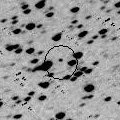
|
Peculiar asteroid moving along a cometary orbit. It keeps observable at 18 mag for a long time from 2008 to 2014. It locates extremely low in the Southern Hemisphere.
Date(TT) R.A. (2000) Decl. Delta r Elong. m1 Best Time(A, h)
Nov. 10 8 7.60 33 19.8 6.635 7.041 110 17.9 4:50 ( 0, 88)
Nov. 17 8 5.58 34 5.8 6.539 7.053 117 17.8 4:21 ( 0, 89)
|
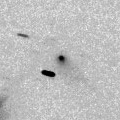
|
First return of a new periodic comet discovered in 2005. Now it is 16.9 mag (Oct. 6, J. F. Hernandez). It will be observable in excellent condition at 17-18 mag until November.
Date(TT) R.A. (2000) Decl. Delta r Elong. m1 Best Time(A, h)
Nov. 10 23 7.97 3 59.8 1.524 2.208 121 17.9 19:48 ( 0, 59)
Nov. 17 23 12.85 4 11.7 1.600 2.215 115 18.1 19:26 ( 0, 59)
|

|
First return of a new periodic comet discovered in 1997 at 17 mag. Now it is 19.2 mag (Sept. 25, Mt. Lemmon Survey). It was expected to keep 17 mag for a long time from 2012 to 2014. But actually, it is fainter than predicted by 2 mag.
Date(TT) R.A. (2000) Decl. Delta r Elong. m1 Best Time(A, h)
Nov. 10 2 0.50 12 54.2 2.929 3.893 164 19.1 22:40 ( 0, 68)
Nov. 17 1 57.26 12 32.0 2.949 3.877 156 19.1 22:09 ( 0, 68)
|
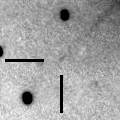
|
It was observed at 17 mag in 2011 autumn. It was expected to be observable at 17 mag in good condition again from autumn to winter in 2012. But actually, the comet is 19.4 mag (Sept. 29, G. Hug), much fainter than this ephemeris. Hidetaka Sato reported that it was not detected, fainter than 21.0 mag (Sept. 21). The comet must have faded out very rapidly.
Date(TT) R.A. (2000) Decl. Delta r Elong. m1 Best Time(A, h)
Nov. 10 6 49.49 30 32.8 2.408 3.103 126 20.3 3:33 ( 0, 85)
Nov. 17 6 47.80 31 57.2 2.355 3.123 133 20.4 3:03 ( 0, 87)
|
|
![]()
 185P/Petriew
185P/Petriew C/2012 V2 ( LINEAR )
C/2012 V2 ( LINEAR ) C/2012 C1 ( McNaught )
C/2012 C1 ( McNaught ) C/2008 S3 ( Boattini )
C/2008 S3 ( Boattini ) (3200) Phaethon
(3200) Phaethon 2012 US136
2012 US136 65P/Gunn
65P/Gunn C/2012 S4 ( PanSTARRS )
C/2012 S4 ( PanSTARRS ) C/2011 A3 ( Gibbs )
C/2011 A3 ( Gibbs ) 2008 YB3
2008 YB3 261P/2012 K4 ( Larson )
261P/2012 K4 ( Larson ) 270P/2012 S5 ( Gehrels )
270P/2012 S5 ( Gehrels ) P/2011 N1 ( ASH )
P/2011 N1 ( ASH )![]()


































